Full Moon Grounding
< PREVIOUS NEXT >
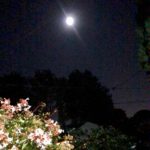
Full moon in summer
The Full Moon Grounding has two parts:
FirstPart: A few minutes after the predicted moonrise, we begin as a group to walk on the trail out into the forest watching slightly to the right for the glow of light coming through the trees. Once we discover the rising moon, we stop and listen for all the sounds as we watch the moon rise. We walk back to Turtleback Zendo looking back from time to time to see the progression of the rising moon. By the time we arrive back, the moon is in the sky, and we have a hot mulled drink and ginger snaps. Then families with young children may leave and those of us left and new arrivals proceed to the second part.
Second Part: This is a one hour outdoor silent meditation (both seated and walking meditation/prayer) under the light of the full moon. A green container is placed near the entrance of the patio. In the container are sheets with directions for using the interactive meditation trail and towels to put down on surfaces where you want to sit, to avoid dampness, leaf litter, etc. You may choose from a variety of places when, where, and for how long you would like to sit and/or walk in meditation. You can change places when ever you would like. A bell sounds when the hour is up and we gather around a fire for hot mulled drink and ginger snaps and the silence is broken.
Full Moon Grounding begins at A few minutes after the actual moonrise. Since on a full moon days, the moon often rise as the sun sets, the moonrise is very late in the evening during the spring and summer months so we will have a Full Moon Grounding around 9PM if and only if, one or more hardy sanga members commit to attending ahead of time.
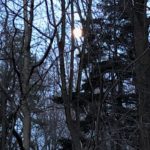
Rising moon in winter
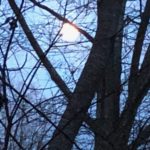
Contining to rise
Mindfulness and awareness of surroundings is key to the fullness of the experience.
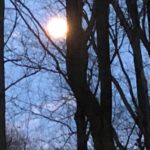
Continuing to rise
What Is a Super Moon?
The super moon is a full moon that occurs when the moon is closest to the earth so a bit larger and a bit brighter.
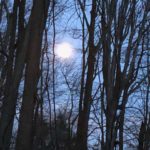
Higher
What Is a Blue Moon?
” The March 1946 issue of
Sky & Telescope misinterpreted the traditional definition, which led to the modern colloquial misunderstanding that a blue moon is a second
full moon in a single
solar calendar month with no seasonal link.”
We might mistakenly consider this second full moon in January to be a blue moon and also the second full. moon on March 31, 2018.
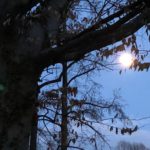
And higher
” The term has traditionally referred to an “extra” moon, where a year which normally has 12 moons has 13 instead. The “blue moon” reference is applied to the third moon in a season with four moons,[2] thus correcting the timing of the last month of a season that would have otherwise been expected too early. This happens every two to three years”
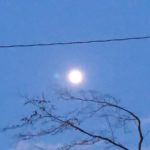
In the sky
Why is it called a blue moon?
- “In calculating the dates for Lent and Easter, Catholic clergy identified a Lenten moon. Historically, when the moons arrived too early, they called the early moon a “betrayer” (belewe) moon, so the Lenten moon came at its expected time.
- Folklore named each of the 12 full moons in a year according to its time of year. The occasional 13th full moon that came too early for its season was called a “blue moon”, so the rest of the moons that year retained their customary seasonal names.”
The term ‘belewe’ meaning betrayer eventually morphed into ‘blue‘.
Why betrayer moon?
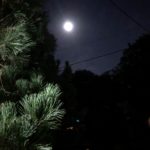
The moon in Autumn
The original meaning would then have been “betrayer moon”, referring to a full moon that would “normally” (in years without an intercalary month) be the full moon of spring, while in an intercalary year, it was “traitorous” in the sense that people would have had to continue fasting for another month in accordance with the season of Lent.[8][9]
For an interesting article on phases of the moon and the pattern of moonrises and moonsets,
The Moon
by Jim Amon
Both my wife and one of my daughters read an earlier draft of this essay and advised me that it didn’t really have anything to do with the Sourlands. All of my other essays have focused on a plant, an animal or an ecological process in the Sourlands. But, even though the Moon is 238,900 miles above the Sourlands, I think that it is an important part of the landscape and deserves it place in this series. I hope that you agree with me.
About four and a half billion years ago, shortly after the Earth was formed, scientists believe that an asteroid crashed into the Earth, loosening a huge mass of material that became the Moon. (Asteroids are the size of minor planets.) Like Earth, the Moon was highly volatile until about a hundred million years ago. Volcanic eruptions sent oceans of lava across its surface. There is evidence that volcanic activity continued at a diminishing rate until about ten million years ago, but as the Moon’s core cooled volcanic eruptions became less frequent and less violent. Meteorites and asteroids slammed into the Moon and meteorites still do. (A meteorite is much smaller that an asteroid; it is an object that has not been burned up by the atmosphere. Meteors become incinerated by the atmosphere and never reach Earth’s surface. Shooting stars are meteors.) The Moon does not have an atmosphere so meteorites still reach the Moon’s surface with some frequency. In fact, one of the concerns that NASA scientists had about landing people on the Moon was that a meteorite could hit them.
Scientists are not sure about the Moon’s core, but they believe that it is a liquid or soft iron, surrounded by a hardened iron, covered by a crust of rock. Much of the rock crust is covered with sand-like ground up stones, the result of the pounding of the Moon’s surface by meteorites. The dust on the surface is stable because there is no water to erode it and, without an atmosphere, there are no winds. The footprints that astronaut Neil Armstrong left when he walked on the Moon are as clear today as they were when he made them in July, 1969.
I am interested in information about the Moon’s origin and geology, and I still thrill at the idea that humans have walked on the Moon, but right now what I want to focus on is the relationship between the Moon and the Earth. For a long time I have been dimly aware that, like the Sun, the Moon more or less rises in the east and sets in—again, more or less, depending on the time of year—the west. But I have never made much effort to look for a pattern of moonrise and moonset. I knew that sometimes it rises before the Sun has set and sometimes it doesn’t rise until many hours of night have passed.
To find a pattern, let’s go back to basics. The Earth orbits the Sun in a counterclockwise pattern, taking a year for a complete orbit. While it is orbiting it is also rotating on its axis counterclockwise, making a complete rotation every twenty-four hours, which creates the pattern of day and night. The Moon orbits the Earth in the same direction but does not rotate. Therefore the same side of the Moon is always facing Earth. The time it takes the Moon to make a complete orbit of Earth is about 27 days.
Astronomers have defined four major phases of the Moon and four minor ones, each minor alternating with a major. The phases are named in a way that is logical to astronomers but not necessarily intuitive to the layperson. When the Moon is between the Sun and the Earth none of the side that is lit by the sun is visible on Earth. Astronomers have named this the “New” Moon because they have decided that the cycle of Moon phases starts at this point. A little more than seven days later, when the right half of the Moon is lit (as seen from Earth) the Moon is said to be in its first quarter. Officially, this is not a half Moon; officially, there is no such thing as a half Moon. It is the first quarter Moon because the Moon is one fourth of the way through its major phases. Next, again a little more than seven days later, the Earth is between the Moon and the Sun so we see the Moon fully illuminated; this, of course is the full Moon. Except during eclipses the Sun, Moon and Earth do not line up in a straight line. The Moon’s orbit is above the Earth’s equator, allowing the Sun’s rays to reach it even when the Earth is between the Moon and the Sun. The next major phase is when the left side of the Moon is lit. This is the third quarter. Then we are back to the “New” Moon. It takes 29.53 days for the Moon to go through all of its phases. The minor phases are when either the right or left side of the Moon appears to be a crescent, or when they appear to be half way between a quarter Moon and a full Moon.
The time of day that the Moon rises or sets is tied to the phases. When the Moon is full the Earth is between the Sun and the Moon, and when the Sun sets the Moon rises. Each day the Moon rises a little more than fifty minutes later than it did the day before. Therefore the day after a full Moon, it rises about fifty minutes after the Sun has set. The next day it rises about one hour and forty minuets after the sunset. The time of moonrise continues at this rate until the Moon is rising and the Sun is setting simultaneously again with the next full Moon.
The idea that people behave aberrantly when the Moon is full goes back to Aristotle. He concluded that since the Moon affects tides and since the human brain is mostly water, the Moon would affect the brains of those who are “susceptible to it.” Apparently Aristotle believed that he was not “susceptible,” and he was right about himself but wrong in his general theory. No one is susceptible. There is too little water in the brain to be affected by lunar tides. His theory never the less has persisted despite the findings of study after study in modern times that have not been able to verify that the full Moon affects human behavior in any way. Crime rates do not increase. Hospitals do not admit more patients. Patients in mental institutions do not act any differently from their usual behavior. We retain a lasting impact of Aristotle’s theory, however, in our language. The Latin word for the moon is Luna, from which the words loony and lunatic are derived.
|
|
The Sourland Conservancy would like to thank our annual business partners for their generous support of our educational, advocacy and stewardship initiatives.
|
|
Sourland Conservancy 83 Princeton Avenue, Suite 1A Hopewell, NJ 08525
|
|
|
|
|
|
|
|
















